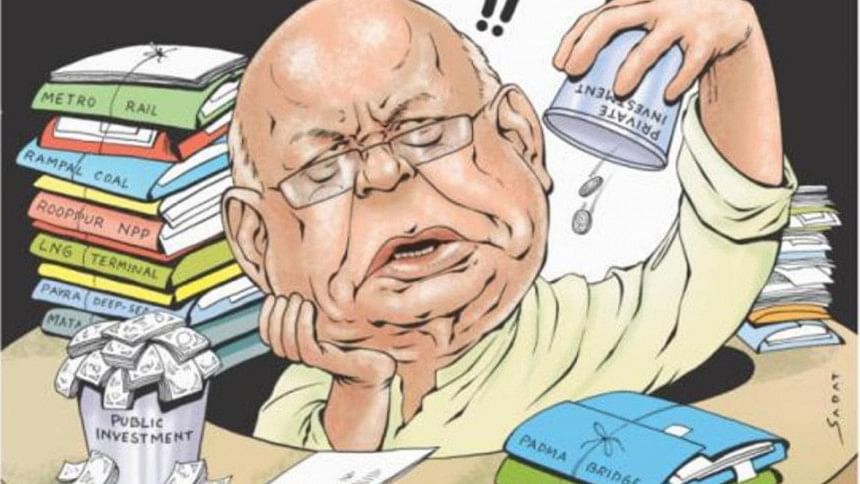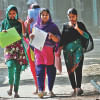Of Obesity or Good Health?

The Finance Minister has proposed a mega Tk.3.4 trillion budget for the upcoming fiscal year 2016-17. It is about 29 percent higher than the revised budget of the outgoing fiscal year. However, despite the traditional growth of the budget size, there are some notable new approaches regarding some mega development projects. For instance, separate allocations have been made for initiating some mega infrastructure and energy projects like the Padma Bridge, the Rooppur Atomic Power Plant, the Matarbari Coal-fired Power Plant and metro rail projects. The initiative was taken last year to separate nationally important project, such as the multi-year public investment programme, as an effort towards reforming the Annual Development Programme (ADP). However, both of them are on the way of their peaceful coexistence.
The size of the ADP, including the allocation for autonomous institutions and authorities, is about 35 percent of the proposed budget. Given the slow rate of implementation, about 50 percent in the first ten months of the outgoing fiscal year, this is the lowest in the last few years. Implementing another 40 percent by May and June is going to produce extremely bad quality output of ADP projects by creating recurrent spikes in the last month, which can be marked as the "June Syndrome". Ironically, a sincere effort is possibly diminished by the sluggish rate of execution by most of the implementing agencies after a verbal order of the Planning Minister at the outset of this fiscal year to execute the ADP by 25 percent in every quarter. With the existing modest and declining capacity of project management and monitoring compared to the expansion of ADP, accelerating execution and maintaining quality is a formidable challenge for the implementing agencies.
As such, there is no surprise other than an 'incremental' approach raising the size of the budget. The Finance Minister seemed to walk through the nitty-gritties of the Medium Term Budgetary Framework (MTBF) to attain the macro, revenue and spending targets. The government will continue to remain a heavy borrower from the banking system. It would create a sense of satisfaction for the lending banks at the end, because the government would absorb a part of the excess liquidity to finance infrastructure, and will at least not turn out to be a defaulter like many heavyweight businesspersons.
The budget is mainly about accelerating growth, economic development and attaining social equality. However, no specific efforts have been clearly outlined in the budget to achieve these three, although it has been assumed that public investment in transportation infrastructure and energy projects would pave the way to achieve the stipulated 7.2 percent growth. Expecting such a growth rate over the next fiscal year should not be 'dreamed' of; it can be achieved with the prevailing circumstances. Rather, we could have easily set a 7.5 percent growth target with a 'mini big push' in private investment, particularly in manufacturing, which accordingly would create an encouraging effect in employment.
Why has the proposed budget carefully avoided more direct measures in attracting private investment, particularly from domestic sources? Perhaps because the Finance Minister thought of lack of readiness in terms of transport infrastructure, energy supply, especially natural gas, and easing of procedures while doing business. Indeed, Bangladesh is now experiencing the best macroeconomic conditions in its history with political stability, magnificent foreign currency reserve, decent export performance and per capita income, low inflationary pressure, and impressive external balance. Indeed, the economy is ready, both horizontally (expand) and vertically (take off), to facilitate steady interplay between private investment and rapid economic growth with aggressive job creation. We are missing out the golden opportunity of administering the aspired 'inclusive' growth as per the Seventh Five-Year Plan.
Overall, the proposed budget has set a weak linkage between growth and development, let alone addressing the persisting high income inequality over one and a half decades. Surprisingly, the Finance Minister has not spent any time on spelling out how to reduce the skyrocketing income disparity through fiscal operations and redistributive measures. Without a serious measure of taming this economic polarisation, it would be very difficult for the government to lessen social disparity. Thus, the budget has remained largely traditional in nature with an assimilation of catchy jargons, which has been mostly criticised by experts and analysts. It may be due to the fact that the entire budget-making apparatus is not yet prepared for fundamental changes, keeping in mind the country's transition to the lower middle-income economy status.
Some critical developmental issues have also been overlooked in the proposed budget. The budget does not explain what changes have been made within it to reform the Social Safety Net Programmes (SSNPs) as per the recent National Social Security Strategy (NSSS). The budget speech has mentioned an incremental approach through increasing coverage and amount of cash transfer. However, a fundamental reform was expected in terms of overhauling the SSNPs to make it more productive, return oriented, and sensitive towards spatial aspects of extreme vulnerability and climate change adaptation. A part of the major programmes, like employment generation for the poorest, vulnerable groups development, etc. could be made adaptive with or without allocative implications.
The greatest philosophical deficit of this budget, despite its gigantic size, is living with the traditional notion of poverty. The budget documents are still in great complacency of cornering the poverty headcount ratio, which is currently estimated to be around 24 percent. However, poverty is no longer a matter of the threshold level of income or expenditure linked with a bundle of food and non-food items. Over a hundred countries in the world are ready to recognise it to be multidimensional with the elements of education, health and standard of living, with ten basic indicators. About half of the population is living with multidimensional poverty as per the latest calculations of Oxford University. By failing to conceive a development paradigm which places multidimensional poverty at the centre of public expenditure, the budget has created a sense of obesity instead of good fiscal health.
The writer is Senior Research Fellow at Bangladesh Institute of International and Strategic Studies (BIISS). E-mail: [email protected].

 For all latest news, follow The Daily Star's Google News channel.
For all latest news, follow The Daily Star's Google News channel. 








Comments